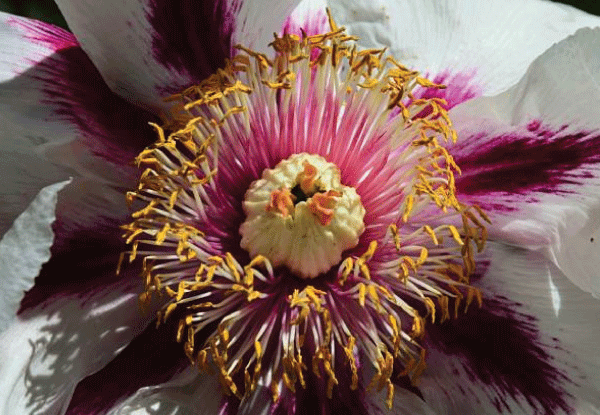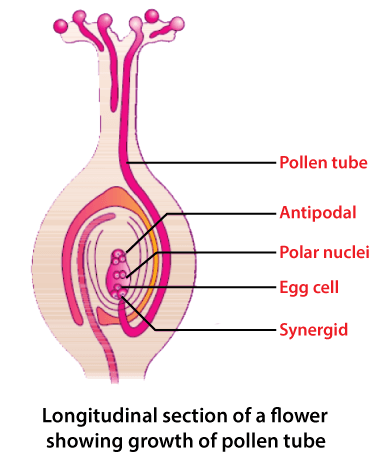Difference between pollination and fertilizationPollination and fertilization occur in plants at the time of reproduction. They're the two major and natural processes involved in reproduction. These methods occur in all known bisexual flowers that contain both the male and feminine plant reproductive organs; anther and stigma respectively. As a result, flowers are considered the reproductive organs of all flowering plants. There are many differences between pollination and fertilization, which are described as follows; PollinationPollination is the transmission of pollen grains from the male organ of a plant to a female organ of a plant and it leads to fertilization. Pollinating mediators transfers helps in the transfer of pollen grains such as animals like insects, birds, and bats; water; wind; and sometimes plants themselves, too, when self-pollination occurs inside a closed flower. These mediators are known as "pollinators". Pollination, most of the time, happens within a manner. 
When the pollen grain (gametophyte) has landed on the stigma, later in angiosperms, it creates the root and develops a pollen tube which keeps growing down along the design till it arrives at an ovary. It is two gametes of it that go along the tube to somewhere to the gametophyte that holds the feminine gametes within the carpel. After coming into an ovum cell with the micropyle, one male nucleus combines along the glacial bodies to supply the endosperm tissues. In contrast, the opposite fuses with the ovule to provide nutrition to the embryo. Therefore the phrase: "double fertilization" is used. This procedure would lead to the creation of a seed product of healthy tissues and embryo both. The ovule later converts itself into seeds and reproduces new plants. Plants use flowers as their "main tool" of pollination and creating their seeds for new plants. But this process can only be done when the process is done between the flowers of the same kind of plants. Plants of similar types can easily breed, but the plant of two different types can't perform this activity because of the different qualities and structures. The pollution is usually done due to the animal's activities done on the plants, such as when they eat or collect pollen for their protein from the plants the pollen grains are attached to their body and when they do the same activity with other plants or flower they drop down to the other flower's stigma, which as a result, produce other plants and a successful reproduction procedure takes place. Types of PollinationPollination can be abiotic or biotic Abiotic pollination: It is done by abiotic factors such as the wind, water, or maybe the rain, etc. Biotic pollination: It is performed by biotic factors like animals, birds, and other pollinators, which help them transfer the pollen grains from one flower to the other plant. The flowers perform two types of pollination:
The procedures of self-pollination and cross-pollination are very similar. Still, for sure, there is a profit for plants during the cross-pollination. The child formed by the pollination can have characteristics of both parents and can be different from the children created by self-pollination. Many plants maintain an entire structure or mechanism to ignore the situation of self-pollination, for example, date palms, etc. In lots of cases, perfect self-pollination occurs at the finish of a flower's lifetime but only when the cross-pollination has not been done. As an example, we can take "fireweed". FertilizationAfter the pollination, plants perform the fertilization procedure; in this process, the male gametes (pollen) of a plant and female gametes (ovum) undergo fusion to create a diploid zygote. This diploid zygote is developed into an embryo. This entire cycle of fertilization and producing a child is called sexual reproduction. Different families of plants have different methods of bringing the male and female gametes together so that they can fertilize. Fertilization in plants was firstly observed in 1884 by the Strassburger. 
Once the pollination is done, the pollen grain germinates, develops a pollen tube, and goes through the ovule with a small pore known as a micropyle. The pollen sends the sperm with the help of the pollen tube to the ovule, in which the egg is fertilized. In blossoming plants, two sperm cells get free from the pollen grain, and a subsequent fertilization event connects the next sperm cell and the central cell of the ovule (next female gamete). The split of the pollen tube to free sperm in Arabidopsis depends on an indication by the female gametophyte. Special proteins known as FER protein kinesis are there in the ovule, which manages the creation of very reactive oxygen species (ROS). ROS levels are at their peak at the time of the floral stage, which is when the ovule easily reaches pollen tubes. Later than being fertilized, the ovary begins to swell up and expand into the fruit. Through multi-seeded fruits, many grains of pollen are required for syngamy among every ovule. The enlargement of the pollen tube is controlled through the vegetative cytoplasm. Even in fertilization, just like pollination, the flowers play the most important role in producing the seeds. Difference between fertilization and pollinationThe process of pollination and fertilization both are part of sexual reproduction and occur inside the plants to create embryos. Still, even after being based on each other, these two are completely different procedures and have differences, but the main difference between these two procedures is that pollen is transferred from one flower to another flower but fertilization occurs only after pollination. There are many other differences between them as listed below;
Next TopicDifference between
|
 For Videos Join Our Youtube Channel: Join Now
For Videos Join Our Youtube Channel: Join Now
Feedback
- Send your Feedback to [email protected]
Help Others, Please Share










